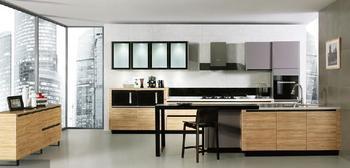 Now there are few big brands in the front line of the cabinet industry, and other brands are rushing to build brand image. The positioning of the terminal in the cabinet market is basically the mode of the franchisee's specialized shop. However, the cabinet terminal data still has not been expanded. What better way can cabinet companies try?
Now there are few big brands in the front line of the cabinet industry, and other brands are rushing to build brand image. The positioning of the terminal in the cabinet market is basically the mode of the franchisee's specialized shop. However, the cabinet terminal data still has not been expanded. What better way can cabinet companies try? Pollution caused by other substances The person in charge said that formaldehyde is not the only basic requirement for furniture environmental protection standards. In addition to formaldehyde, hazardous substances such as benzene and hydrazine may also be present in cabinets. In addition to the panels, there are cabinet panels and adhesives that need to be processed in order to ensure that the content of harmful substances does not exceed the standard.
The physical damage of the cabinet itself is also one of the reasons why the cabinet is not environmentally friendly. Materials, poorly-operated cabinets may have burrs, sharp corners, fast mouths, etc. in the details. These unreasonable parts can easily cause bodily harm. Handling food directly on the cupboard may be due to the quality of the countertop, which may lead to accidental eating of impurities, debris, etc., which may cause health hazards.
Cabinets also suffer from noise, light and other pollution problems. To avoid these problems, we must use high-quality hardware and reasonably select panels and countertops.
In addition, kitchen waste is also an important cause of cabinet pollution. Kitchens have long been considered as a "manufacturing shop" for rubbish, and it has become commonplace to soil floors and clog sinks, and to clean up residual rubbish, breed bacteria easily and attract "four evils."
The non-recyclable material causes the waste cabinet. Environmental protection not only means that it does not cause damage to the human body, but it should also meet the environmental conservation standards.
In terms of the environmental protection of materials, aluminum is better than stainless steel, because the boiling point of aluminum is relatively low, only 200 degrees, while stainless steel is up to 2,000 degrees, which is not conducive to the recycling of materials.
Some inconspicuous parts, such as the adjustment feet of the cabinet, can be fully used plastic back materials, as long as its strength is qualified, there is no need to use the so-called ABS plastic (one of the five major synthetic resins) and so on.
Whether or not the cabinet design is reasonable and energy-saving is also an important criterion for judging whether cabinets are environmentally friendly.
The selection of cabinet sink directly affects the use of tap water. Compared with the currently popular double-tank water tank, the single large water tank saves water more; because the large water tank needs more water, the double water tanks can be dip and washed apart, and the water can be used more rationally.
Gas stove settings should try to avoid the tuyere. If installed near a door, the gas will be affected by the flowing air during use. Not only the use of gas will increase, but soot will be blown away by the wind and cannot be absorbed, which will affect the work of the range hood.
The use of insecurity can also cause pollution. Is the cabinet material in compliance with the environmental standards, and the design can save you peace of mind?
According to the person in charge of the European wardrobe and cabinet, the correct use of the cabinets is also very important.
The person in charge said that cabinets are places where water, electricity and coal are gathered together. If these three things are used improperly, they will cause harm to the environment and even affect personal safety. The overflow outlet in the sink should be set reasonably; electrical appliances, wires and plugs should be protected from electrical leakage; there should also be gas valves, flameout protection, etc.
PRODUCT NAME:Aluminum Phosphate, Aluminum Metaphosphate ,Potassium Silicate Curing Agent
PRODUCT TYPE:High Temperature Materials, Binder
PRODUCT APPEARANCE:White Powder
CHEMICAL CLASS:AlPO4
CAS No.:7784-30-7.
PRODUCT APPLICATION:It can solidify potassium silicate (other name: potassium water glass) at room temperature. It is mostly used as binder and curing agent in the production of Hi-Temp Refractory Materials for kiln. It also serves as fluxing agent in the production of special glass, as binder in fabrication of ceramics or tooth, and so on.
Aluminum phosphate adhesive has excellent heat-resistance and weather-resistance, not only a widely used adhesive in refractories, it`s also an importantingredient in inorganic coatings(such as powder coating). It also used in the production of siliceous,high-aluminum,magnesian,siliconcarbide and oxides of concrete.
TECHNICAL DATA
|
Test Items |
Technical Parameters |
|
Appearance |
White Powder |
|
The PH Value |
2-4 |
|
Residue on sieve(45um)% |
≤0.5% |
|
P2O5 % |
60-70 |
|
Al2O3 % |
25-35 |
STANDARD PACKAGING: 25kg/bag, Plastic-lined and plastic-coated woven bags or Composite paper bags.
TRANSPORT AND STORAGE
Protect against weathering and exposed under the blazing sun. Store in a cool,dry place and avoid extreme fluctuations in temperature.
Special conditions for opened packaging: Close bags after use to prevent the absorption of moisture and contamination.
High Temperature Resistant Materials Series
High Temperature Resistant Materials Series, Aluminium Tripolyphosphate Hydrogen, Fireproofing Material Condensed Aluminum Phosphate
shijiazhuang city xinsheng chemical co.,ltd , http://www.xsphos.com